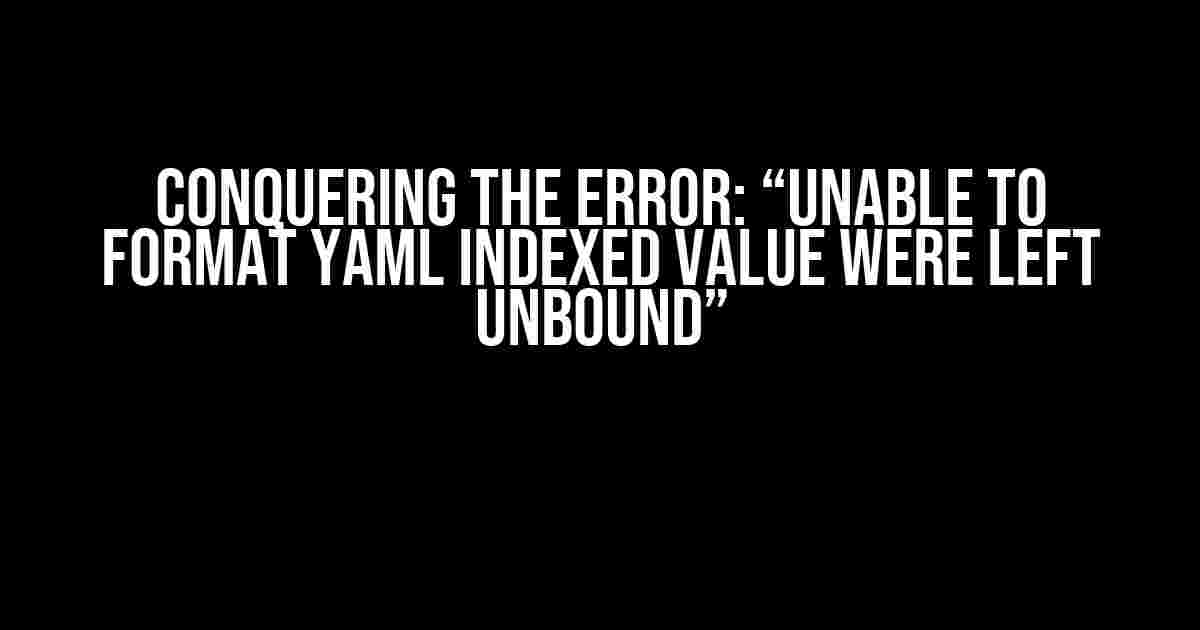What Does the Error Mean?
Have you ever encountered the frustrating error message “Unable to format YAML indexed value were left unbound” while working with YAML files? If so, you’re not alone! This error can be puzzling, especially for those new to YAML. But don’t worry, we’re here to break it down and provide a step-by-step guide to resolve this issue once and for all.
What is YAML?
Before we dive into the error, let’s quickly cover the basics of YAML (YAML Ain’t Markup Language). YAML is a human-readable serialization format commonly used for configuration files, data exchange, and debugging. It’s a popular choice among developers due to its simplicity, flexibility, and ease of use.
What Causes the Error?
The “Unable to format YAML indexed value were left unbound” error typically occurs when there’s a mismatch between the YAML data structure and the templating engine’s expectations. This can happen when:
- The YAML file contains invalid syntax or formatting.
- The templating engine is not compatible with the YAML version.
- The YAML data structure is not properly defined or indexed.
- There are unbound variables or placeholders in the YAML template.
Resolving the Error: A Step-by-Step Guide
Fear not, dear developer! With these straightforward steps, you’ll be able to identify and fix the issue in no time.
Step 1: Verify YAML Syntax and Formatting
Check your YAML file for any syntax errors or inconsistencies. Ensure that:
- Indentation is correct (spaces, not tabs).
- Colons (:) are used to separate keys from values.
- Commas (,) separate items in lists.
- Dashes (-) are used to denote list items.
- Quotes are used correctly (double quotes for strings, single quotes for identifiers).
# Example of correct YAML syntax foo: bar: baz qux: quux list: - item1 - item2 - item3
Step 2: Check YAML Version Compatibility
Verify that your YAML file is compatible with the templating engine you’re using. Make sure:
- You’re using the correct YAML version (e.g., YAML 1.2).
- The templating engine supports the YAML version.
Step 3: Define and Index YAML Data Structure
Ensure that your YAML data structure is properly defined and indexed. Use:
- Clear and concise key names.
- Indexed arrays or lists for storing multiple values.
- Nested structures for organizing complex data.
# Example of a well-defined YAML data structure
data:
user:
name: John Doe
age: 30
items:
- item1: foo
item2: bar
- item1: baz
item2: qux
Step 4: Identify and Bind Unbound Variables
Search for any unbound variables or placeholders in your YAML template. Replace:
- Unbound variables with actual values.
- Placeholders with correctly indexed values.
# Example of replacing unbound variables
template:
greeting: "Hello, {{ user.name }}!"
items:
- "{{ items[0].item1 }}: {{ items[0].item2 }}"
- "{{ items[1].item1 }}: {{ items[1].item2 }}"
Step 5: Test and Validate Your YAML File
Once you’ve made the necessary changes, test and validate your YAML file using:
- A YAML validator (e.g., YAML Validator Online).
- A templating engine’s built-in validation tools.
Common Scenarios and Solutions
In this section, we’ll tackle some common scenarios where the “Unable to format YAML indexed value were left unbound” error may occur, along with their solutions.
Scenario 1: Unbound Variables in a Template
Suppose you have a YAML template with unbound variables:
template:
greeting: "Hello, {{ user.name }}!"
items:
- "{{ items[0].item1 }}: {{ items[0].item2 }}"
Solution: Replace the unbound variables with actual values or correctly indexed values:
data:
user:
name: John Doe
items:
- item1: foo
item2: bar
- item1: baz
item2: qux
template:
greeting: "Hello, {{ user.name }}!"
items:
- "{{ items[0].item1 }}: {{ items[0].item2 }}"
- "{{ items[1].item1 }}: {{ items[1].item2 }}"
Scenario 2: Incorrect YAML Syntax
Imagine you have a YAML file with incorrect syntax:
data user: name: John Doe age: 30 items - item1 foo - item2 bar
Solution: Correct the YAML syntax and formatting:
data:
user:
name: John Doe
age: 30
items:
- item1: foo
item2: bar
Conclusion
There you have it! With these comprehensive steps and examples, you should be able to resolve the “Unable to format YAML indexed value were left unbound” error and get back to developing with confidence. Remember to:
- Verify YAML syntax and formatting.
- Check YAML version compatibility.
- Define and index YAML data structure correctly.
- Identify and bind unbound variables.
- Test and validate your YAML file.
By following these guidelines, you’ll be well-equipped to tackle even the most complex YAML-related issues. Happy coding!
| YAML Best Practices | Description |
|---|---|
| Use clear and concise key names | Improves readability and maintainability |
| Indent correctly (spaces, not tabs) | Avoids syntax errors and improves readability |
| Define and index data structures properly | Simplifies data access and reduces errors |
| Use quotes correctly (double quotes for strings, single quotes for identifiers) | Avoids syntax errors and improves readability |
Frequently Asked Questions
Q: What is the most common cause of the “Unable to format YAML indexed value were left unbound” error?
A: The most common cause is a mismatch between the YAML data structure and the templating engine’s expectations, often due to invalid YAML syntax or unbound variables.
Q: Can I use tabs instead of spaces for indentation in YAML?
A: No, YAML requires spaces for indentation, not tabs. Using tabs can lead to syntax errors and make your YAML file incompatible with certain tools.
Q: How do I troubleshoot YAML-related issues?
A: Start by verifying YAML syntax and formatting, then check YAML version compatibility, and finally, identify and bind unbound variables. You can also use YAML validators and templating engine’s built-in validation tools to aid in troubleshooting.
Frequently Asked Question
Stuck with the “Unable to format YAML indexed value were left unbound” error? Don’t worry, we’ve got you covered! Check out these FAQs to troubleshoot the issue and get back to coding in no time.
What does the “Unable to format YAML indexed value were left unbound” error mean?
This error occurs when your YAML file contains indexed values that are not properly bound to a key. Think of it like trying to put a key in a lock that doesn’t fit – it just won’t work! Check your YAML file for any typos, missing colons, or incorrect indentation that might be causing the issue.
How do I identify the problematic YAML indexed value?
To find the culprit, carefully review your YAML file, paying attention to any lines with indexed values (e.g., `my_array: [value1, value2]`). Look for syntax errors, missing quotes, or unbalanced brackets. You can also try using a YAML validator tool to help pinpoint the issue.
Can I fix the “Unable to format YAML indexed value were left unbound” error by modifying my YAML file?
Yes, in most cases, you can fix the error by correcting the YAML syntax and ensuring that all indexed values are properly bound to a key. Make sure to use the correct indentation, colons, and quotes to define your YAML arrays and objects.
What if I’m using a YAML parser or library, and I’m still getting the error?
If you’re using a YAML parser or library, double-check the documentation to ensure you’re using the correct API methods and configurations. You might need to update your parser or library to the latest version or adjust your code to handle YAML errors more robustly.
Are there any tools that can help me troubleshoot YAML errors like “Unable to format YAML indexed value were left unbound”?
Yes, there are several online YAML validators and editors that can help you identify and fix errors in your YAML files. Some popular options include YAMLLint, YAML Validator, and JSON Editor. These tools can save you time and frustration when working with YAML files.



